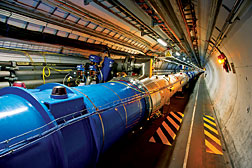- Number 382 |
- February 18, 2013
Upgrades extend the reach of the LHC

The Large Hadron Collider (Photo: CERN).
The Large Hadron Collider, the largest particle accelerator in the world, started colliding particles more than three years ago. Since then, scientists have published more than 700 papers detailing the knowledge they have gained at the cutting edge of particle physics. But much work still lies ahead for the LHC, starting this March with a two-year shutdown during which scientists, engineers and technicians will prepare the machine to run at higher energy.
In the LHC, superconducting magnets steer two beams of protons in opposite directions along a 17-mile ring more than 300 feet beneath the border of Switzerland and France. The beams cross paths in four locations along the ring. When a proton from one beam collides with a proton from the other, the energy of the collision can convert into mass, creating new, massive particles. These particles quickly decay into lighter particles, leaving a whole zoo of particles for scientists to study.
Since the LHC turned on, the ATLAS, CMS, LHCb and ALICE experiments—along with the smaller experiments TOTEM and LHCf—have discovered a total of three particles and recorded a wealth of information on particle interactions at energies never studied before. More than 1,800 scientists based in the United States have been involved in this research, funded by the Department of Energy and the National Science Foundation.
Undisputedly, the most famous insight so far has been the discovery of what seems to be the long-sought Higgs boson. This particle is thought to arise from the fluctuation of the invisible “Higgs field” that pervades the universe, imparting mass to particles that interact with it. Without the Higgs field, our world would be a much different place. The two other particle discoveries revealed composite particles known as Chi-b(3P) and Xi(b)*, which are made of quarks and antiquarks.
Now the LHC is about to extend its reach. Collisions at higher energies can create particles with more mass. At 13 trillion electronvolts, the LHC will be able to access a new realm of masses and states of matter never before seen in manmade accelerators.
“We could be looking at a new framework,” says CMS deputy spokesperson Joao Varela, a physicist with the Portuguese institute LIP.
Work on the accelerator will raise the energy of each particle beam in the accelerator to 6.5 trillion electronvolts. Starting in 2015, scientists expect to collect data from more than 200 quadrillion particle collisions at that energy.
“At the LHC, the streetlamps are just beginning to turn on, and we can see under some of the lampposts now,” says John Ellis, a theorist and professor at King’s College London. “Eventually, the pools of light will join up and we’ll be able to see everything.”
There is still much to learn about the new, Higgs-like particle. And there is still much more territory to cover in the search for new physics. Nature certainly has many more mysteries for scientists to explore. The higher energy will enable scientists to expand their search for supersymmetric particles, dark-matter particles, extra dimensions and other new phenomena.
“We are at the beginning,” says Aleandro Nisati, who leads the ATLAS collaboration’s studies of how the LHC upgrades will expand the potential of future physics analyses. “This is a new, big chapter in high-energy physics.”Submitted by DOE’s Fermi National Accelerator Laboratory
